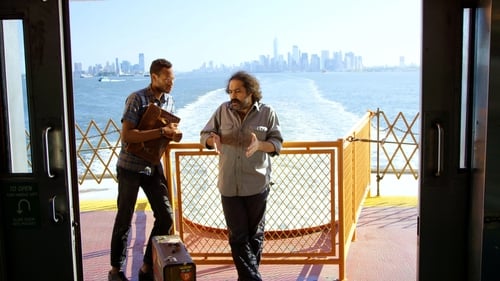
Art Direction
In 1948 the James Agee wrote a scenario for his lifelong hero, Charlie Chaplin. Deeply disturbed by the bombing of Hiroshima and Nagasaki, Agee imagined New York destroyed. In the ruins, Chaplin's Little Tramp builds a shack in Central Park. Gradually a small community of the dispossessed grows up around him. For Agee, his story was a thought experiment about how one might start again in the aftermath of disaster, to go beyond capitalism and just how hard that is in the face of our modern technological world. The film focuses on his imaginative journey and what it might mean for us today.

Colorist
In 1948 the James Agee wrote a scenario for his lifelong hero, Charlie Chaplin. Deeply disturbed by the bombing of Hiroshima and Nagasaki, Agee imagined New York destroyed. In the ruins, Chaplin's Little Tramp builds a shack in Central Park. Gradually a small community of the dispossessed grows up around him. For Agee, his story was a thought experiment about how one might start again in the aftermath of disaster, to go beyond capitalism and just how hard that is in the face of our modern technological world. The film focuses on his imaginative journey and what it might mean for us today.

Editor
In 1948 the James Agee wrote a scenario for his lifelong hero, Charlie Chaplin. Deeply disturbed by the bombing of Hiroshima and Nagasaki, Agee imagined New York destroyed. In the ruins, Chaplin's Little Tramp builds a shack in Central Park. Gradually a small community of the dispossessed grows up around him. For Agee, his story was a thought experiment about how one might start again in the aftermath of disaster, to go beyond capitalism and just how hard that is in the face of our modern technological world. The film focuses on his imaginative journey and what it might mean for us today.

Production Design
In 1948 the James Agee wrote a scenario for his lifelong hero, Charlie Chaplin. Deeply disturbed by the bombing of Hiroshima and Nagasaki, Agee imagined New York destroyed. In the ruins, Chaplin's Little Tramp builds a shack in Central Park. Gradually a small community of the dispossessed grows up around him. For Agee, his story was a thought experiment about how one might start again in the aftermath of disaster, to go beyond capitalism and just how hard that is in the face of our modern technological world. The film focuses on his imaginative journey and what it might mean for us today.

Cinematography
In 1948 the James Agee wrote a scenario for his lifelong hero, Charlie Chaplin. Deeply disturbed by the bombing of Hiroshima and Nagasaki, Agee imagined New York destroyed. In the ruins, Chaplin's Little Tramp builds a shack in Central Park. Gradually a small community of the dispossessed grows up around him. For Agee, his story was a thought experiment about how one might start again in the aftermath of disaster, to go beyond capitalism and just how hard that is in the face of our modern technological world. The film focuses on his imaginative journey and what it might mean for us today.

Cinematography
Zoe Beloff Surprise: Bertold Brecht and Walter Benjamin have been reincarnated as an Iranian and an African-American and they roam today’s New York. At times they are a comic duo, at others the voice of our conscience: the babbling couple provides good weapons to attack the world.

Editor
Zoe Beloff Surprise: Bertold Brecht and Walter Benjamin have been reincarnated as an Iranian and an African-American and they roam today’s New York. At times they are a comic duo, at others the voice of our conscience: the babbling couple provides good weapons to attack the world.

Director of Photography
The saga of a movie treatment written by German playwright Bertolt Brecht during his unhappy stint in Hollywood based on a Life Magazine article about a farm family who win a week's stay in a model home at the Ohio State Fair, with the catch that they will be on display to the public.

Director of Photography
An exploration of Soviet director Sergei Eisenstein's notes and drawings for a science fiction movie that he pitched to Paramount in 1930 about the residents of a skyscraper with walls and floors of clear glass.

Director of Photography
Russian avant-garde filmmaker Sergei Eisenstein and German playwright Bertolt Brecht recount the brief portions of their lives they spent in Hollywood trying to make art that was both radical and popular.








